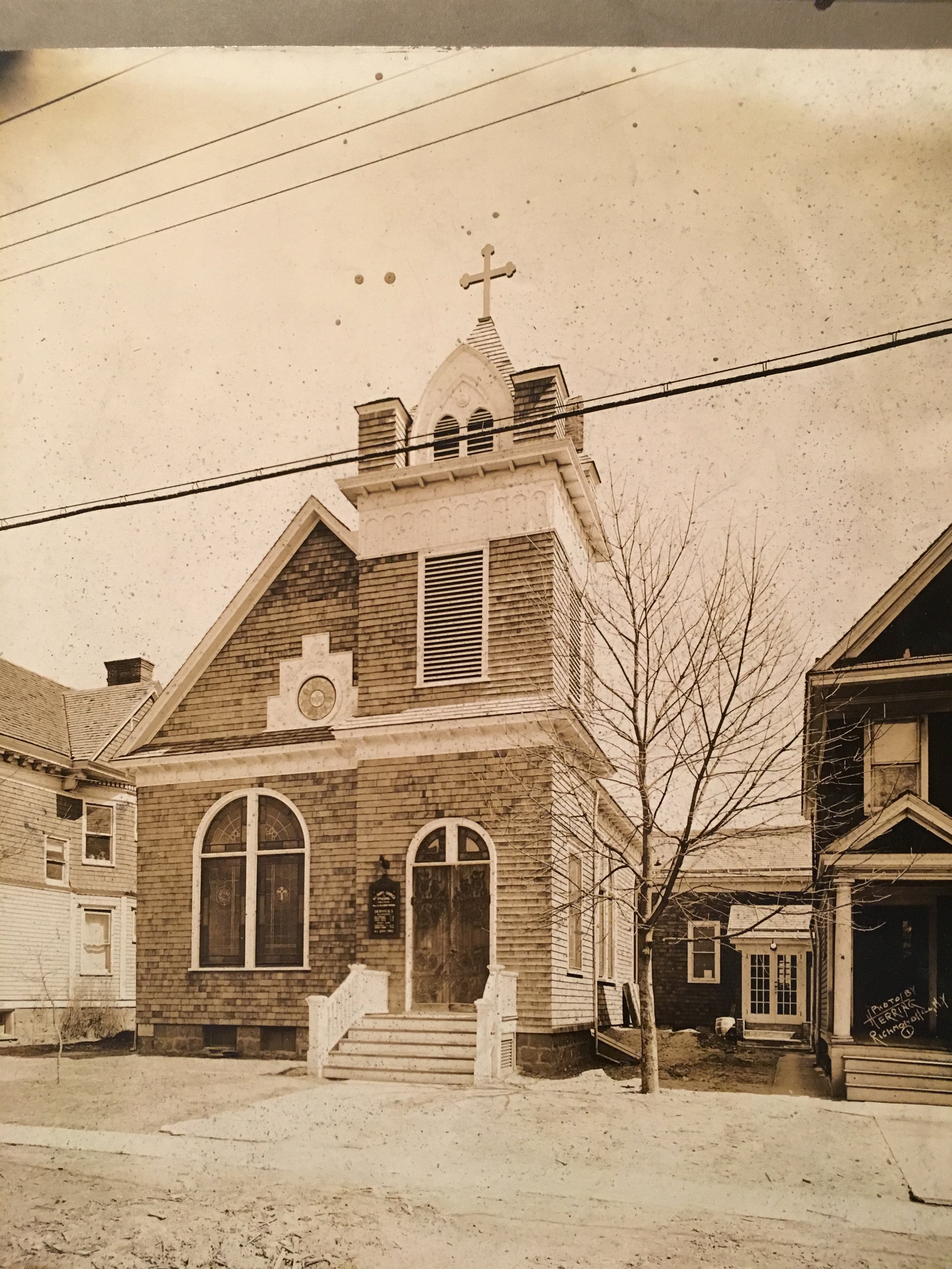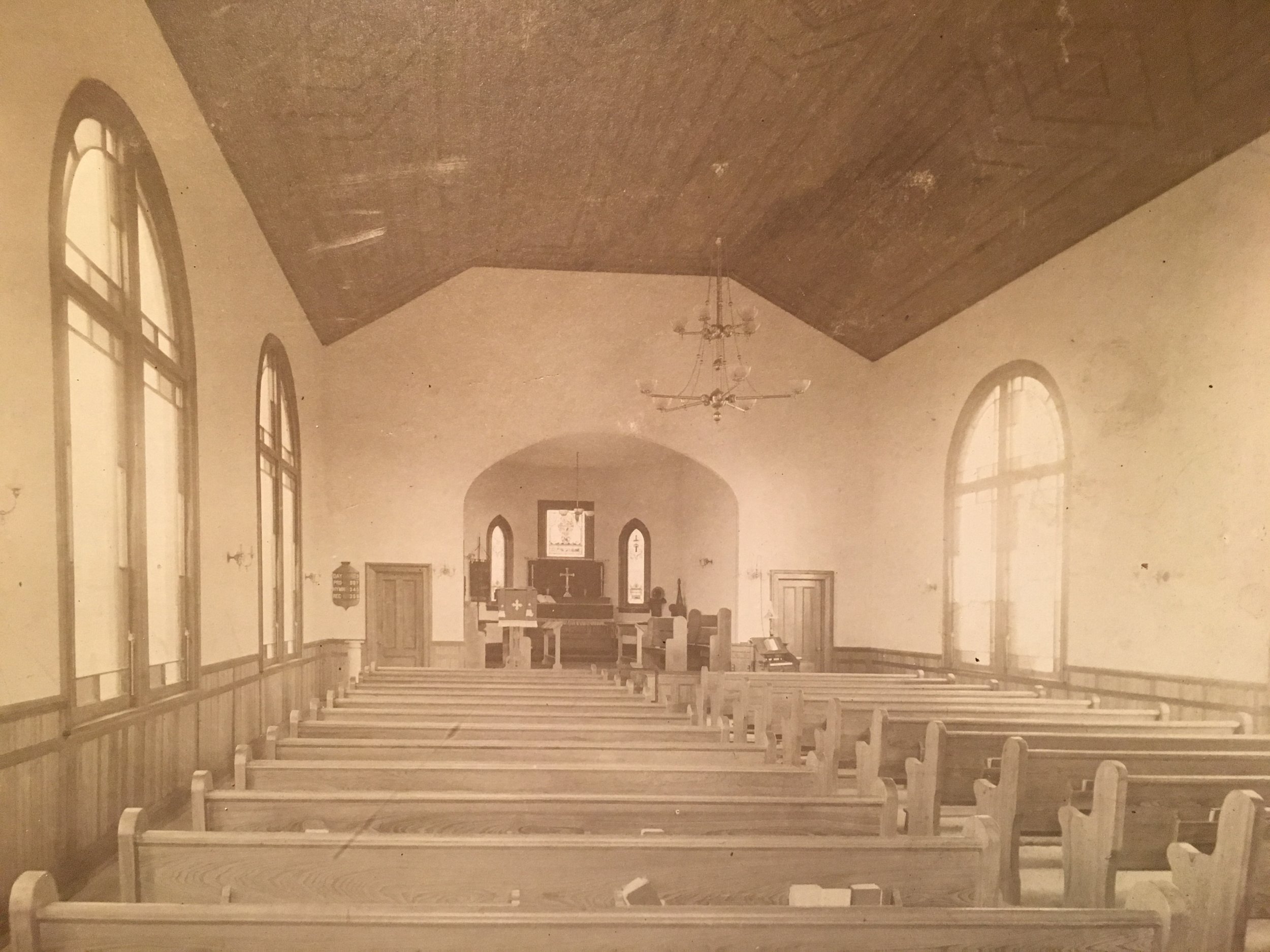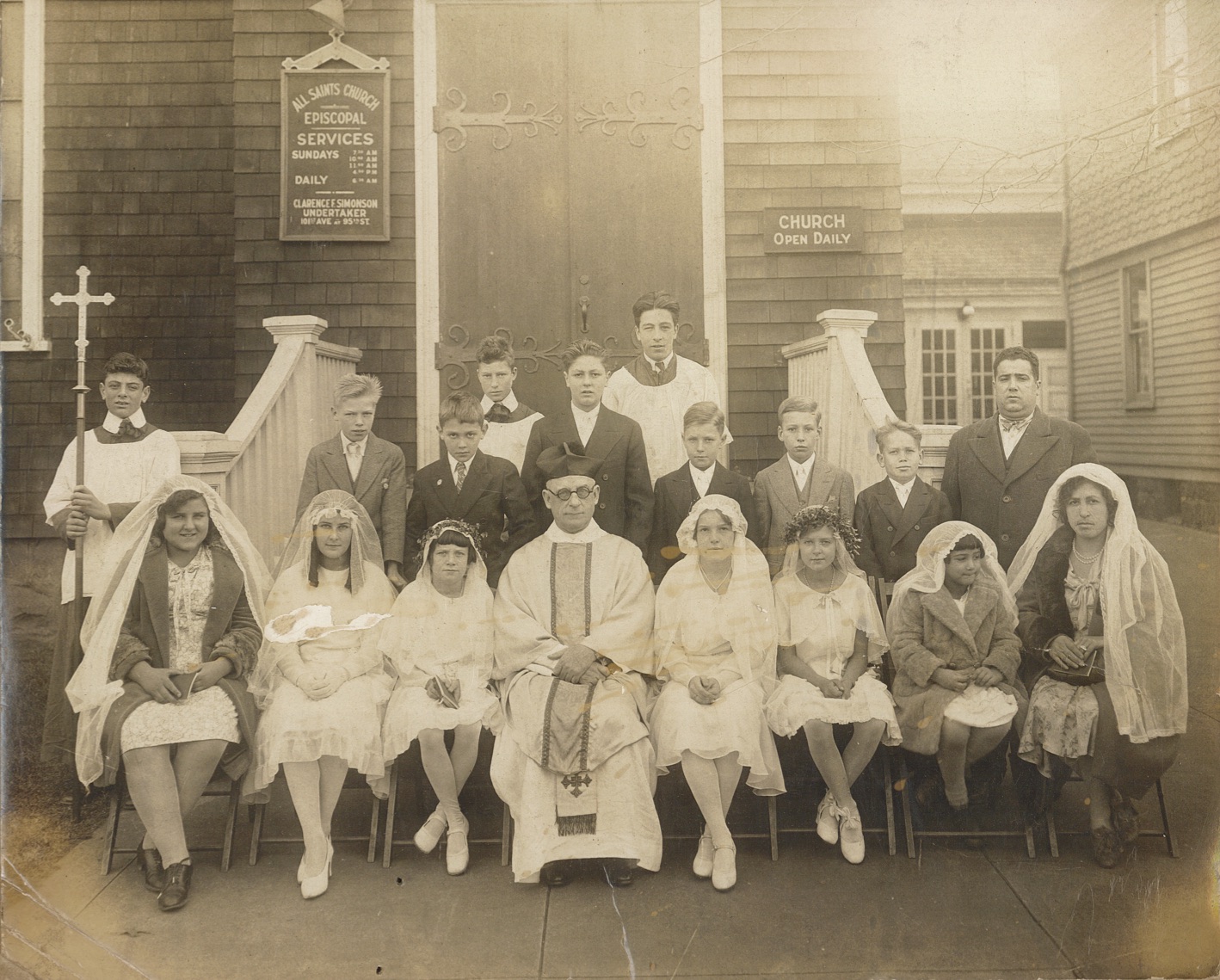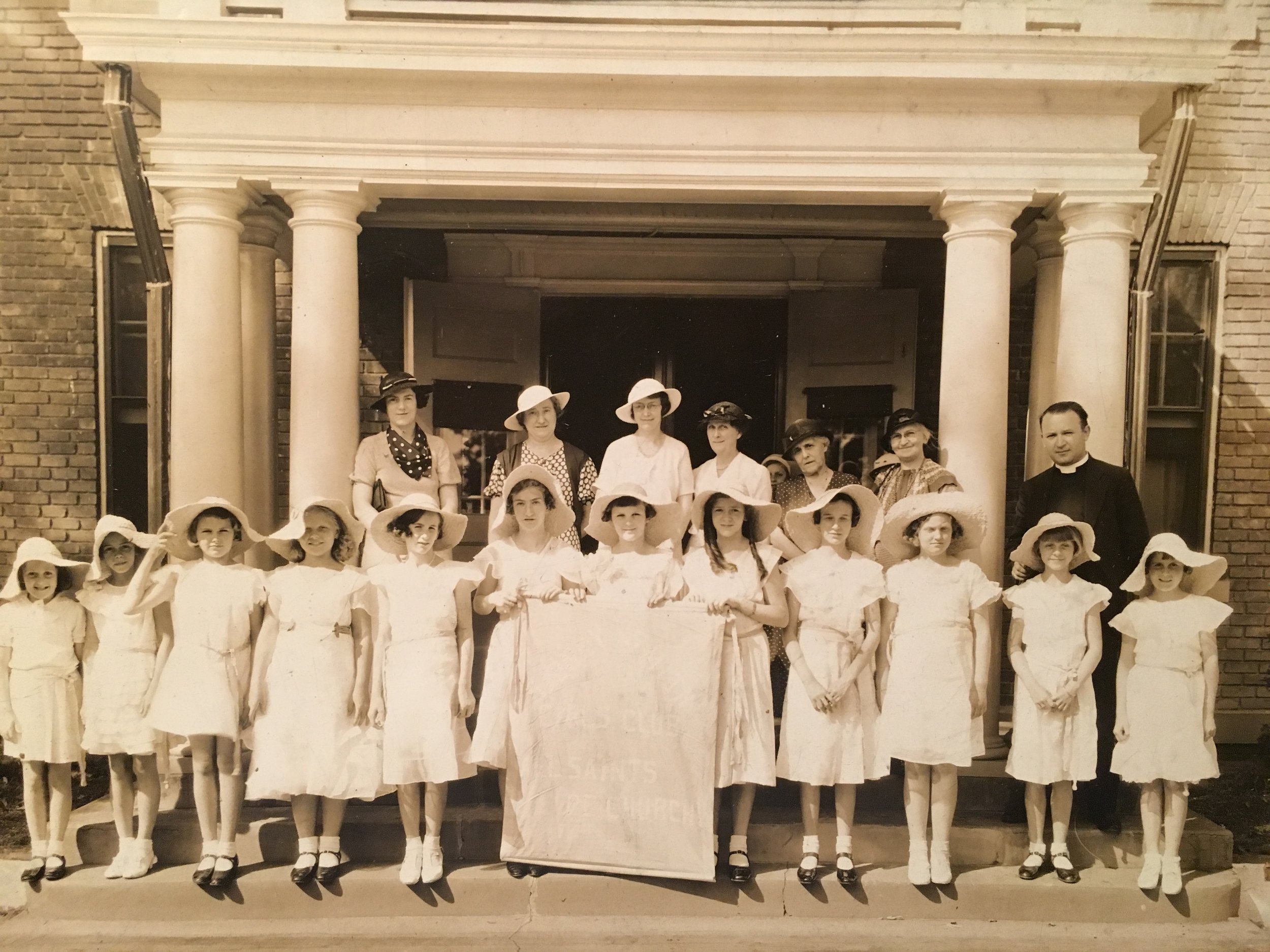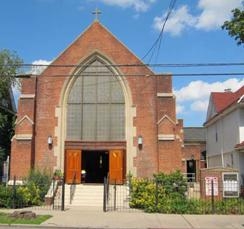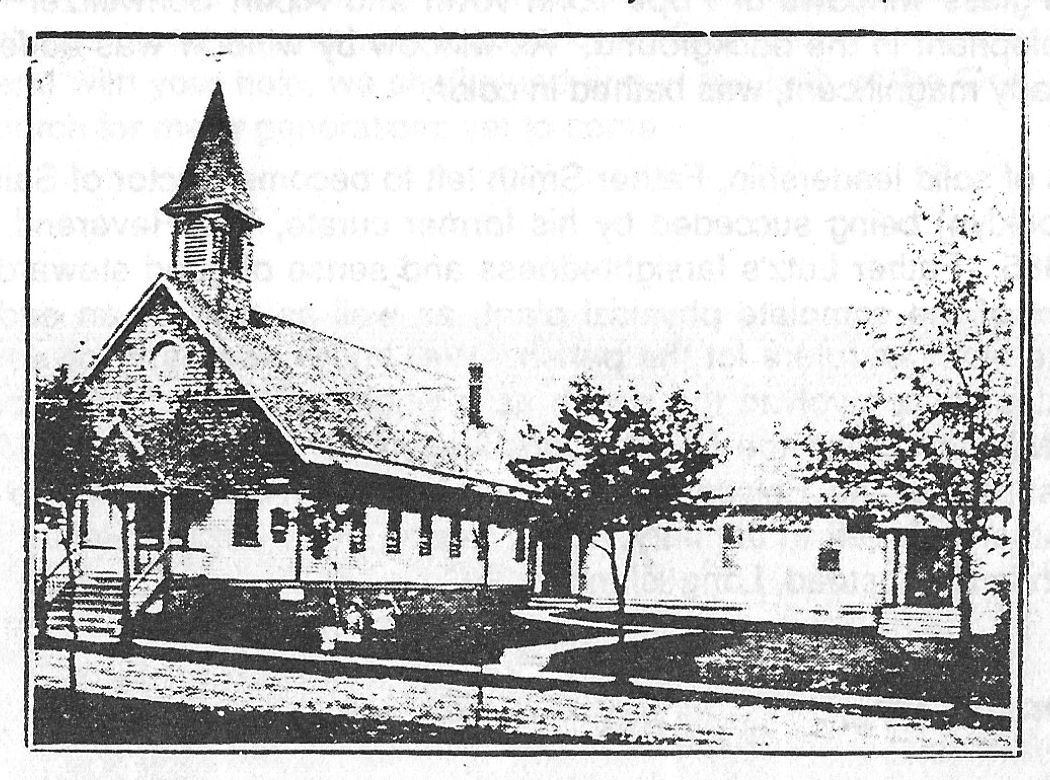The first building, ca. 1900.
The first building, before 1939.
The nave interior, date unknown.
Confirmation Day, date unknown.
Confirmation Day, date unknown.
Facade of the second building.
Celebration of the Mass, 2013.
Procession out of the church at the final mass in South Richmond Hill. (2013)
Exterior of All Saints, Woodhaven.
Nave, looking toward the West Window.
The High Altar, Easter 2016.
ALL SAINTS CHURCH (1897 - Present)
On Sunday, November 26, 1897 the Rev. Henry Quimby held the first service and organized a Sunday School for the Episcopalians of South Richmond Hill, or Morris Park as it was called then. A store on Jerome Avenue served that first small gathering, which included six children. The humble beginning is accented by the report of the sum of $22 raised by “entertainment,” which formed the basis of a fund to purchase property for a permanent church. During Eastertide 1900 three lots on Lefferts “Avenue” were purchased. The cornerstone was laid on August 12, 1900 and on All Saints Day of that year the first service was held in the new church.
The Rev. John Graham became the first permanent and resident priest in 1901. When he arrived, Morris Park was an area of woods and farms and All Saints was a country church. The church served as both a worship center and place of social gathering. The latter, as might be expected, was sparked by the women of St. Helena’s Guild. Many events were held in community halls and private homes. The Vicar's home was the center of activity particularly at Bazaar time.
The Rev. Henry Armstrong succeeded Mr. Graham and carried the work of the church into the post-war years of the 1920’s. During his tenure the Rectory was acquired adjacent to the church. This period also saw the construction of the Parish Hall.
During the depression days of the 1930’s we were served by the Rev. Lewis Beissig. The faith and work of hundreds of people throughout forty years brought fruit in 1938 when All Saints mission became a parish, and Mr. Beissig was elected the First Rector. Our faith was put to the test on December 13, 1939 when fire destroyed a large portion of the church building. Through sacrifice and hard work the church and parish hall were restored and improved.
A new era began for All Saints in 1948 when the restored church, now free of all debt, was consecrated by Bishop De Wolfe. In 1940, The Rev. Frederic Bush became the Second Rector, ministering faithfully for thirteen years. Because of failing health, Fr. Bush decided to retire in 1953. He was succeeded by the Rev. Edward Haslam, Third Rector. Fr. Haslam became a familiar figure in the community. He was active in the Interfaith movement projecting the parish into the life of our area. After ten years he moved to Brooklyn, and was succeeded by the Rev. Fred Sutton, Fourth Rector and an excellent teacher and liturgical scholar.
In 1965, the Rev. John J.T. Schnabel was elected Fifth Rector, beginning the longest tenure to date. In these twenty-one years the parish has continued to grow and prosper. All obligations of the Diocesan and Parochial nature were met, which was rare in the urban scene of that time.
During Fr. Schnabel’s tenure a number of changes and additions were made to the church buildings. Heating was converted from oil to more economic gas. The large west window was completely releaded and rebuilt with added crowns, the symbols of All Saints. The sacristy, located off the sanctuary, was completely renovated with the addition of cabinets, sink, piscina and working area along with new closets, lighting and floor. The sanctuary was redesigned and enlarged with the altar moved to the center with more ease of liturgical movement in mind. The altar rail was moved forward and enlarged to provide more than double the kneeling capacity. The choir and organ were moved to the west end of the church into space provided and the baptistry moved to the far eastern gospel side of the nave. Through a bequest all new pews were purchased and installed along with padded kneelers. A nave altar was installed to provide for more intimate weekday celebrations of the Eucharist. This altar was also used as the altar of repose on Maundy Thursday. The Children’s Chapel was also renovated and refurbished for the use of the Sunday School. The kitchen, located in the parish hall, was gutted to the walls and all new equipment and cabinets were installed. A new set of specially designed front doors were installed. During the winter of 1990 it was realized that the church organ was failing. A committee was formed to examine various instruments and suggest a proper replacement and a new Rogers organ was purchased and installed during June of 1991.
As important as these improvements were to the corporate worship, more important was the growth in numbers and the diversity of the membership. Our parishioners came from five continents and represented many and various ethnic groups. We became a microcosm of the worldwide Anglican Communion. Sadly, Fr. Schnabel died on July 16, 1992, due to complications from emphysema.
On February 17, 1993, the vestry unanimously elected The Rev. Roy Edmund Waywell as Sixth Rector. He assumed his duties on Sunday, March 28, 1993. Under Fr. Waywell's leadership All Saints continued to flourish and grow. He introduced many elements of traditional catholic worship, and during his tenure, All Saints was named as The Cell of the Holy House of Our Lady of Walsingham and St. Martin de Porres. Fr. Waywell served as Rector for 16 years, until his untimely death on August 31, 2009.
The Rev. Lloyd Henry was eventually chosen as Interim Rector. During this interim period, All Saints discerned a call to relocate from its home since 1897 in South Richmond Hill to the Woodhaven neighborhood into the site that had been St. Matthew’s Church, which closed in 2011. Following the decision to relocate, the parish resumed its search for a new rector. The Rev. Dr. Norman Whitmire, Jr. was elected as the Seventh Rector, and he began his tenure on July 1, 2013.
Fr. Whitmire’s first task as the new Rector was to relocate the parish to the newly renovated Woodhaven site. All Saints began its ministry in Woodhaven on October 25, 2013 with a grand celebration to reconsecrate the historic 1928 Gothic-revival building and install Fr. Whitmire as Rector. Since that time, All Saints has worked to make connections to the Woodhaven community. One of the most significant endeavors is the monthly community project to restore, maintain, and renovate the historic Wyckoff-Snedicker Cemetery, in which members of some of the founding families of Queens and Brooklyn are buried (Eldert, Snedicker, van Wicklen, Lott, van Dine). All Saints also offers services in Spanish to serve the large number of persons living in Woodhaven from Latin America.
In 2017, All Saints Episcopal Church attempted a ministry relationship with All Saints/Todos los Santos Lutheran Community, a predominately Spanish-speaking congregation, worshipping and working together in order to minister to the Latino/a community of Woodhaven. The relationship continued until the summer of 2020.
In the spring of 2020, All Saints was forced to close its doors for the first time in its history due to a worldwide pandemic of the coronavirus SARS-CoV-2, which caused the devastating respiratory illness known as COVID-19. Nevertheless, the ministry of All Saints never ceased; masses were streamed live from the Rectory over the Internet until the fall. Although in-person masses resumed in October of that year, All Saints continued its commitment to evangelism by live streaming all High Masses, weekday masses, and various other services over the internet.
All Saints celebrated its 125th Anniversary in November, 2022. The festivities culminated in a grand celebration during All Saints Week, which included the Annual Requiem Mass for All Souls Day, a Pontifical Sung Rosary & Benediction, Gala Dinner & Dance, and Festive High Mass.
All Saints seeks to transform lives through reverent worship in the catholic tradition, while embracing the diversity of its members and the Woodhaven community. All Saints is a friendly, inclusive, and diverse parish where all are warmly welcome.
For a gallery of these historic pictures of All Saints, Richmond Hill, click here.

















